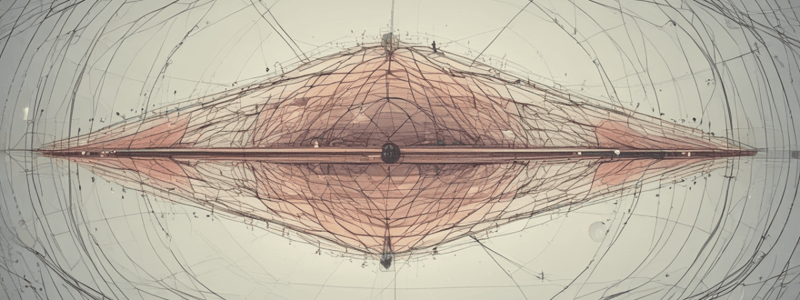Podcast
Questions and Answers
Which of the following statements about vectors and scalars is TRUE?
Which of the following statements about vectors and scalars is TRUE?
- The dot product of two vectors is always a scalar. (correct)
- Scalars can be represented by arrows, while vectors cannot.
- The magnitude of a vector is always a scalar, but the direction can be a vector.
- The sum of two vectors is always a vector with the same magnitude as the original vectors.
If two vectors are perpendicular, what is the value of their dot product?
If two vectors are perpendicular, what is the value of their dot product?
- The dot product is undefined for perpendicular vectors.
- 1
- 0 (correct)
- -1
What is the difference between displacement and distance?
What is the difference between displacement and distance?
- Displacement and distance are the same thing, just measured in different units.
- Displacement is a scalar quantity, while distance is a vector quantity.
- Distance is the total path traveled, while displacement is the shortest path between the starting and ending points. (correct)
- Displacement is the total path traveled, while distance is the shortest path between the starting and ending points.
Which of the following represents the dot product of two vectors a and b?
Which of the following represents the dot product of two vectors a and b?
A vector is multiplied by a scalar of -2. What happens to the vector?
A vector is multiplied by a scalar of -2. What happens to the vector?
Which of the following is NOT a way to represent a vector in a 2D plane?
Which of the following is NOT a way to represent a vector in a 2D plane?
If two vectors are added together, what is the resulting vector called?
If two vectors are added together, what is the resulting vector called?
What does resolving a vector into its components mean?
What does resolving a vector into its components mean?
What is the angle between two vectors if their dot product is equal to zero?
What is the angle between two vectors if their dot product is equal to zero?
Which of the following is NOT true about the dot product of two vectors?
Which of the following is NOT true about the dot product of two vectors?
What is the primary difference between speed and velocity?
What is the primary difference between speed and velocity?
How do you add vectors in a 2D plane?
How do you add vectors in a 2D plane?
What is the purpose of the i-j plane?
What is the purpose of the i-j plane?
What is the result of multiplying a vector by a scalar?
What is the result of multiplying a vector by a scalar?
What is the dot product of two vectors used for?
What is the dot product of two vectors used for?
What is the condition for two vectors to be equal?
What is the condition for two vectors to be equal?
What is the commutative property of the dot product?
What is the commutative property of the dot product?
What can be used to describe a vector in a 2D plane?
What can be used to describe a vector in a 2D plane?
What is the angle between two vectors if their dot product is zero?
What is the angle between two vectors if their dot product is zero?
What is the purpose of resolving a vector into its components?
What is the purpose of resolving a vector into its components?
Which of the following statements about vectors and scalars is TRUE?
Which of the following statements about vectors and scalars is TRUE?
What is the primary purpose of resolving a vector into its i and j components?
What is the primary purpose of resolving a vector into its i and j components?
If two vectors are perpendicular, what can be said about their dot product?
If two vectors are perpendicular, what can be said about their dot product?
Which of the following is NOT a valid way to describe a vector in a 2D plane?
Which of the following is NOT a valid way to describe a vector in a 2D plane?
What is the significance of the angle between two vectors when calculating their dot product?
What is the significance of the angle between two vectors when calculating their dot product?
Two vectors are considered equal if they have the same:
Two vectors are considered equal if they have the same:
What is the result of multiplying a vector by a scalar?
What is the result of multiplying a vector by a scalar?
Which of the following statements about the dot product is TRUE?
Which of the following statements about the dot product is TRUE?
What is the dot product of two vectors used for?
What is the dot product of two vectors used for?
Which of the following is NOT a valid way to represent a vector in the i-j plane?
Which of the following is NOT a valid way to represent a vector in the i-j plane?
Flashcards are hidden until you start studying
Study Notes
Vectors and Scalars
- A scalar is a quantity with only magnitude, like a normal number, and speed is an example of a scalar.
- A vector is a quantity with both magnitude and direction, and velocity is an example of a vector.
- Distance is a scalar that measures the length of the path traveled, while displacement is a vector that measures how far an object is from its starting point.
Vectors as Arrows
- Vectors can be represented as arrows and are often denoted with an arrow over the letter.
- Two vectors are equal if and only if they have the same direction and magnitude.
- A vector can be multiplied by a scalar, which scales its length.
- Vectors can be added "tip to tail".
The i-j Plane
- The i-j plane is a way to express a vector using only numbers by splitting the plane into two perpendicular axes, i and j.
- Every vector in a 2D plane can be broken down into its i and j components, which describe how much it goes across (i direction) and how much it goes up (j direction).
- Resolving a vector into its components is a way to describe it, and the opposite of this is finding the resultant vector.
The Resultant Vector and Vector Forms
- The resultant vector is the result of adding a vector's i and j components.
- There are two ways to describe a vector: rectangular form (using i and j) and polar form (using magnitude and direction).
The Dot Product
- The dot product is a way to multiply vectors, and it gives a scalar answer.
- The dot product is commutative, meaning the order of the vectors does not matter.
- The dot product can be used to find the angle between two vectors using the formula:
a · b = |a| |b| cos(θ). - If two vectors are perpendicular, their dot product is equal to 0, because
cos(90) = 0.
Vectors and Scalars
- A scalar is a quantity with only magnitude, like a normal number, and speed is an example of a scalar.
- A vector is a quantity with both magnitude and direction, and velocity is an example of a vector.
- Distance is a scalar that measures the length of the path traveled, while displacement is a vector that measures how far an object is from its starting point.
Vectors as Arrows
- Vectors can be represented as arrows and are often denoted with an arrow over the letter.
- Two vectors are equal if and only if they have the same direction and magnitude.
- A vector can be multiplied by a scalar, which scales its length.
- Vectors can be added "tip to tail".
The i-j Plane
- The i-j plane is a way to express a vector using only numbers by splitting the plane into two perpendicular axes, i and j.
- Every vector in a 2D plane can be broken down into its i and j components, which describe how much it goes across (i direction) and how much it goes up (j direction).
- Resolving a vector into its components is a way to describe it, and the opposite of this is finding the resultant vector.
The Resultant Vector and Vector Forms
- The resultant vector is the result of adding a vector's i and j components.
- There are two ways to describe a vector: rectangular form (using i and j) and polar form (using magnitude and direction).
The Dot Product
- The dot product is a way to multiply vectors, and it gives a scalar answer.
- The dot product is commutative, meaning the order of the vectors does not matter.
- The dot product can be used to find the angle between two vectors using the formula:
a · b = |a| |b| cos(θ). - If two vectors are perpendicular, their dot product is equal to 0, because
cos(90) = 0.
Vectors and Scalars
- A scalar is a quantity with only magnitude, like a normal number, and speed is an example of a scalar.
- A vector is a quantity with both magnitude and direction, and velocity is an example of a vector.
- Distance is a scalar that measures the length of the path traveled, while displacement is a vector that measures how far an object is from its starting point.
Vectors as Arrows
- Vectors can be represented as arrows and are often denoted with an arrow over the letter.
- Two vectors are equal if and only if they have the same direction and magnitude.
- A vector can be multiplied by a scalar, which scales its length.
- Vectors can be added "tip to tail".
The i-j Plane
- The i-j plane is a way to express a vector using only numbers by splitting the plane into two perpendicular axes, i and j.
- Every vector in a 2D plane can be broken down into its i and j components, which describe how much it goes across (i direction) and how much it goes up (j direction).
- Resolving a vector into its components is a way to describe it, and the opposite of this is finding the resultant vector.
The Resultant Vector and Vector Forms
- The resultant vector is the result of adding a vector's i and j components.
- There are two ways to describe a vector: rectangular form (using i and j) and polar form (using magnitude and direction).
The Dot Product
- The dot product is a way to multiply vectors, and it gives a scalar answer.
- The dot product is commutative, meaning the order of the vectors does not matter.
- The dot product can be used to find the angle between two vectors using the formula:
a · b = |a| |b| cos(θ). - If two vectors are perpendicular, their dot product is equal to 0, because
cos(90) = 0.
Studying That Suits You
Use AI to generate personalized quizzes and flashcards to suit your learning preferences.




